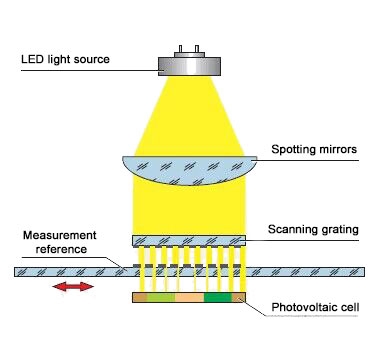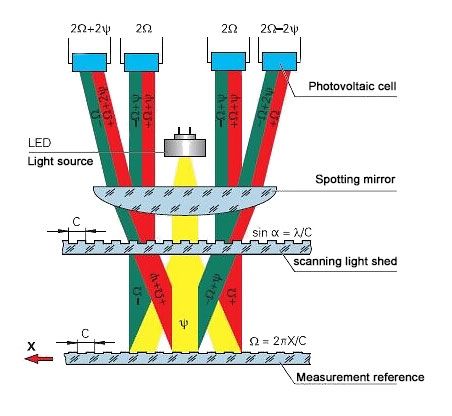Linear scale is a kind of sensor widely used in measurement and positioning systems, which realizes high precision measurement by detecting the phase change of light. This linear scale usually consists of a light source, a grating, a detector, and a signal processing unit, and has the advantages of high precision and fast response speed. The following is a detailed article from the sisco store about the working principle of linear scale.
The Working Principle of Linear Scale
The working principle of linear scale is based on the interference phenomenon of light. The linear scale head contains a series of grating lines that are very evenly spaced. When light passes through these lines, an interference phenomenon occurs, forming light and dark stripes. The spacing of these fringes is closely related to the spacing of the encoder lines. During measurement, one end of the linear scale head is connected to the object to be measured, while the other end is connected to the reading instrument. When the object to be measured moves, the linear scale head also moves, resulting in a change in the relative position of the encoder lines. By measuring the changes in the light and dark stripes on the linear scale head, the displacement of the object to be measured can be determined.
Imaging Scanning Principle
Simply put, the imaging scanning principle uses transmitted light to generate a signal: a linear scale and a scanning grating of the same or similar pitch move relative to each other. The base of the scanning grating is transparent, while the linear scale, which serves as the measuring reference, can be either transparent or reflective. When parallel light passes through a grating, a light/dark area is formed at a certain distance, and the scanning mask is located at this position. When two gratings are moved relative to each other, the light passing through the linear scale is modulated. If the slits are aligned, the light passes through. If the scribe lines of one grating are aligned with the slits of the other, the light does not pass through. A set of regularly arranged photocells converts these changes in light intensity into electrical signals. A special form of scanning grating modulates the light intensity into a nearly sinusoidal output signal.

Interference Scanning Principle
The interference scanning principle utilizes the diffraction and interference of fine gratings to create signals for position measurement movements. Linear scales with stepped light are inscribed on a flat reflective surface with a 0.2 um high reflective line. The linear scale in front of the scanning grating, its grating distance, and linear scale grating distance are the same, it is the transmission phase grating.
When the light shines on the scanning grating, the light is diffracted into three beams of light intensity approximation: -1, 0, and +1. In the light wave diffracted by the linear scale, the strongest beams of diffracted light intensity of the reflected light are +1 and -1. These two beams of light in the scanning grating meet again at the phase light shed, and once again be diffracted and interfered with. It forms three beams of light that leave the scanning grating at different angles. The photocell converts these alternating light intensity changes into electrical signals.
The relative motion of the scanning grating and the linear scale causes the diffracted light of the first stage to be phase-shifted: when the grating is moved over a pitch, the +1 diffracted light of the previous stage is shifted in the positive direction by one light wavelength, and the -1 diffracted light is shifted in the negative direction by one light wavelength. Since these two light waves will interfere when they leave the scanning grating, the light waves will be shifted by two wavelengths relative to each other. That is to say, relative movement of a grating distance can be obtained in two signal periods.

Linear Scale Working Steps
- Emission of Light from a Light Source: The operation of linear scale begins with the emission of light from a light source. This is usually a laser or LED beam. As the light passes through the grating lines of the linear scale head, an interference phenomenon occurs.
- Interference Fringe Formation: When light passes through the grating lines, light and dark interference fringes are formed. The formation of these fringes is caused by the superposition of light waves and phase differences. The pitch of the grating lines determines the pitch of the fringes, and this pitch is closely related to the accuracy of the measurement.
- Linear Scale Head Connected to the Object to be Measured: One end of the linear scale head is connected to the object to be measured, usually a moving axis or platform. As the object moves, the linear scale head moves with it, causing the relative positions of the interference fringes to change.
- Movement of the Linear Scale Head: As the object to be measured moves, the interference fringes in the linear scale head change. This change is very small and precise and can therefore be used to measure small displacements of an object.
- Interference Fringes are Measured by a Readout Instrument: The readout instrument is located at the other end of the linear scale head and is used to measure changes in the interference fringes. The readout can be a photodiode array or other photodetector. It converts the interference fringes on the linear scale head into an electrical signal.
- Conversion to Displacement: The readout instrument converts the measured electrical signal into a displacement value. This process usually involves complex signal processing and mathematical operations to produce the final displacement result.
The Working Process of Linear Scale
First, the system activates a light source that emits light. The light passes through the grating lines of the linear scale head, creating light and dark interference fringes. One end of the linear scale head is connected to the object to be measured, ensuring that the linear scale head follows the movement of the object. When the object to be measured moves, the linear scale head also moves, causing the relative positions of the interference fringes to change.
The photodetectors in the readout instrument sense the change in the interference fringes and convert it into an electrical signal. The electrical signal undergoes complex signal processing to extract information related to the displacement of the object. After mathematical operations, the final displacement value of the measured object is obtained. The final displacement value is usually shown on a display for the user to observe and record.
As a high-precision measurement and positioning sensor, high quality linear scale realizes accurate measurement of position by using the fluctuation of light and the principle of interference. Its structure is simple, stable work, and is widely used in machinery manufacturing, semiconductor production, and other fields. With the continuous progress of science and technology, linear scale will continue to play an important role in the field of precision measurement, promoting the development of industrial automation and intelligent manufacturing.

